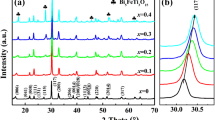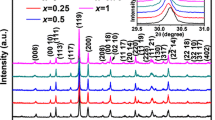Abstract
We present the structural, dielectric, ferroelectric, magnetic and magnetoelectric studies of lead free; single phase Bi4−x Sm x Ti3−x Co x O12−δ (0 ≤ x ≤ 0.07) ceramics, synthesized using a standard solid-state reaction technique. Raman spectroscopy analysis reveals the relaxation of distortion in TiO6 octahedron. Field emission scanning electron microscopy confirmed the growth of plate-like grains. It is observed that with the substitution of Sm3+ and Co3+ ions the dielectric constant, loss tangent and ferroelectric transition temperature decreases. Electrical dc resistivity, remnant polarization and magnetization increases with increasing Sm3+ and Co3+ contents. The magnetoelectric coupling co-efficient, α = 0.65 mV cm−1 Oe−1 is realized for Bi4−x Sm x Ti3−x Co x O12−δ (x = 0.07) ceramic sample. Our results clearly demonstrate the lead free, multiferroic nature of Sm/Co-substituted Bi4Ti3O12, which may find useful application in designing cost-effective electromagnetic devices.









Similar content being viewed by others
References
Eerenstein W, Mathur ND, Scott JF (2006) Multiferroic and magnetoelectric materials. Nature 442:759–765
Aken BBV, Rivera JP, Schmid H, Fiebig M (2007) Observation of ferrotoroidic domains. Nature 449:702–705
Fiebig M (2005) Revival of magnetoelectric effect. J Phys D Appl Phys 38:R123–R152
Khomskii DI (2006) Multiferroics: different ways to combine magnetism and ferroelectricity. J Magn Magn Mater 306:1–8
Schmid H (1994) Multi-ferroic magnetoelectrics. Ferroelectrics 162:317–338
Wood VE, Austin AE (1975) Magnetoelectric interaction phenomenon in crystals. In: Freeman AJ, Schmid H (eds), Gordon and Breach, New York, pp 181–194
Hill NA (2000) Why are there so few magnetic ferroelectrics. J Phys Chem B 104:6694–6709
Smolenskii GA, Chupis IE (1982) Ferroelectromagnets. Sov Phys Usp 25:475–493
Jona F, Shirane G (1993) Ferroelectric crystals: Dover, New York
Khomskii DI (2001) Magnetism and ferroelectricity: why do they so seldom co-exist. Bull Am Phys Soc C 21:002
Nan CW, Bichurin MI, Dong S, Viehland D, Srinivasan G (2008) Multiferroic magnetoelectric composites: historical perspective, status, and future directions. J Appl Phys 103:031101
Fiebig M, Lottermoser T, Fröhlich D, Goltsev AV, Pisarev RV (2002) Observation of coupled magnetic and electric domains. Nature 419:818–820
Muto M, Tanabe Y, Sakano TI, Hanamura E (1998) Magnetoelectric and second harmonic spectra in antiferromagnetic Cr2O3. Phys Rev B 57:9586–9607
Kimura T, Goto T, Shinatani H, Ishizaka K, Arima T, Tokura Y (2003) Magnetic control of ferroelectric polarization. Nature 426:55–58
Palkar VR, Malik SK (2005) Observation of magnetoelectric behaviour in Pb(Fe x Ti1−x )O3. Solid State Commun 134:783–786
Kumar M, Yadav KL (2007) Observation of room temperature magnetoelectric coupling in a Ni substituted Pb1−xNixTiO3. J Appl Phys 102:076107
Herbert JM (1982) Ferroelectric transducers and sensors: Gordon and Breach, New York.
Jardiel T, Caballero AC, Villegas M (2008) Aurivillius ceramics: Bi4Ti3O12-based Piezoelectrics. J Ceram Soc Jpn 116:511–518
Yao YY, Song CH, Bao P, Su D, Lu XM, Zhu JS, Wang YN (2004) Doping effect on the dielectric property in bismuth titanate. J Appl Phys 95:3126–3130
Lu J, Qiao LJ, Chu WY (2008) Comparison of room temperature multiferroic in Bi4Fe2TiO12 film and bulk. J Univ Sci Technol B 15:782–788
Chen XQ, Yang FJ, Cao WQ, Wang DY, Chen K (2010) Room temperature magnetoelectric coupling in Bi4(Ti1Fe2)O12-δ system. J Phys D Appl Phys 43:065001
Chen XQ, Yang FJ, Cao WQ, Wang DY, Chen K (2010) Enhanced multiferroic characteristics in Fe-doped Bi4Ti3O12 ceramics. Solid State Commun 150:1221–1224
Park BH, Kang BS, Bu SD, Nch TW, Lee J, Jo W (1999) Lanthanum-substituted bismuth titanate for use in non-volatile memories. Nature 401:682–684
Kim JS, Kim SS (2005) Ferroelectric properties of Nd-substituted bismuth titanate thin films processed at low temperature. Appl Phys A 81:1427–1430
Shigyo T, Kiyono H, Nakano J, Itoh H, Takahashi J (2008) Synthesis and dielectric-magnetic properties of rare-earth (La, Nd, Sm)-modified Bi4Ti3O12. Jpn Soc Appl Phys 47:7617–7622
Srinivas A, Boey FYC, Sritharan T (2005) Samarium modified strontium bismuth niobate: synthesis and ferroelectro-magnetic property evaluation. Mater Sci Eng B 123:222–226
Jungang H, Kumar RV (2011) B-site multi-element doping effects on electrical property of Bismuth Titanate Ceramics. Ferroelectrics-Physical effects. InTech, China, pp 244–274
Shannon RD (1976) Revised ionic radii and systematic studies of interatomic distances in halides and chalcogenides. Acta Crystallogr A A32:751–767
Yonenda Y, Kohara S, Mizuki J (2006) Pair-Distribution Function Analysis of Bismuth Titanate. J Jpn J Appl Phys 45:7556
Kojima S, Shimada S (1996) Soft mode spectroscopy of bismuth titanate single crystals. Phys B 219(220):617
Kojima S (2000) Raman spectroscopy of bismuth layer structured ferroelectrics. Ferroelectrics 239:55–62
Zhu J, Chen XB, Zhang ZP, Shen JC (2005) Raman and X-ray photoelectron scattering study of lanthnum-doped strontium bismuth titanate. Acta Mater 53:3155–3162
Graves PR, Hua G, Myhra S, Thompson JG (1995) The Raman modes of the Aurivillius Phases: Temperature and Polarization Dependence. J Solid State Chem 114:112–122
Liu HL, Yoon S, Cooper SL, Cheng SW, Han PD, Payne DA (1998) Probing anisotropic magneto-transport in manganese pervoskites using Raman spectroscopy. Phys Rev B 58:R10115
Verma KC, Kotnala RK, Negi NS (2008) Improved dielectric and ferromagnetic properties in Fe-doped PbTiO3 nanoparticles at room temperature. Appl Phys Lett 92:152902
Rachna S, Bhattacharyya S, Gupta SM (2010) Correlating structure, dielectric and impedance studies with lanthanum-ion substitution in bismuth titanate. Mater Sci Eng B 175:207–212
Jiang QY, Subbarao EC, Cross LE (1994) Effect of composition and temperature on electric fatigue of La-doped lead zirconate titanate ceramics. J Appl Phys 75:7433
Hsiang HI, Yen FS (1996) effect of crystallite size on the ferroelectric domain growth of ultrafine BaTiO3 powders. J Am Ceram Soc 79:1053–1060
Yi WY, Hui WX, Tu LL (2010) Ferroelectric and dielectric properties of La/Mn co-doped Bi4Ti3O12 ceramics. Chin Phys B 19:037701
Coey JMD, Douvalis AP, Fitzgerald CB, Venkatesan M (2004) Ferromagnetism in Fe-doped SnO2 thin films. Appl Phys Lett 84:1332–1334
Chen X, Wei C, Xiao J, Yue Y, Zeng X, Yang F, Li P, He Y (2013) Room temperature multiferroic properties and magneto-capacitance effect of modified ferroelectric Bi4Ti3O12 ceramics. J Phys D Appl Phys 46:425001
Ren Z, Xu G, Wei X, Liu Y, Hou X, Du P, Weng W, Shen G, Han G (2007) Room temperature ferromagnetism in Fe-doped PbTiO3 nanocrystals. Appl Phys Lett 91:063106
Singh A, Gupta A, Chatterjee R (2008) Enhanced magnetoelectric coefficient in the modified BiFeO3-PbTiO3 system with large La substitution. Appl Phys Lett 93:022902
Srinivas A, Kim DW, Hong KS, Suryanarayan SV (2003) Observation of ferroelectromagnetic nature in rare-earth substituted bismuth iron titanate. Appl Phys Lett 83:2217–2219
Acknowledgements
We would like to acknowledge Dr. Mahavir Singh and Dr. Nagesh Thakur, Department of Physics Himachal Pradesh University, Shimla, India for magnetic, ferroelectric and dielectric measurements. Joginder Paul is thankful to the department of Higher Education Himachal Pradesh-India for providing study leave to conduct this work.
Author information
Authors and Affiliations
Corresponding author
Rights and permissions
About this article
Cite this article
Paul, J., Bhardwaj, S., Sharma, K.K. et al. Room-temperature multiferroic properties and magnetoelectric coupling in Bi4−x Sm x Ti3−x Co x O12−δ ceramics. J Mater Sci 49, 6056–6066 (2014). https://doi.org/10.1007/s10853-014-8328-7
Received:
Accepted:
Published:
Issue Date:
DOI: https://doi.org/10.1007/s10853-014-8328-7




